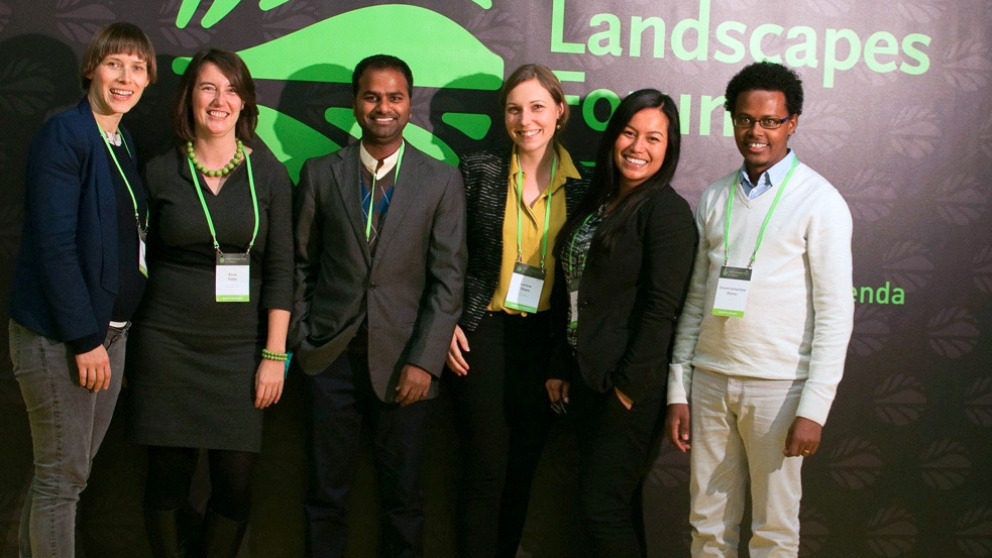Healthy Soils and Climate Protection: Global Landscapes Forum on the Sidelines of COP21 Focuses on Land Use
09.12.2015

The role of healthy soils in climate protection and food security is a major focus of the COP21 international climate summit in Paris. More than half of the 158 submitted Intended Nationally Determined Contributions (INDCs) ascribe importance to the agricultural sector. In particular African and Asian countries are aiming for more sustainable use of soils and land. At the same time, population growth is putting pressure on many of them to increase their productivity in order to ensure food security. This dilemma was highlighted by Ravi Prabhu, Deputy Director of the World Agroforestry Centre (ICRAF) during a discussion organised by the French think tank IDDRI and the IASS on 6 December as part of the Global Landscapes Forum. This platform for exchanging ideas on land use questions took place on the sidelines of the COP21 summit in Paris on 5 and 6 December. It brought together 2,500 players from many different sectors, including agriculture and forestry, water, energy, law and finance.

Involving small farmers is a must
Soil degradation presents a serious threat to food security, especially in countries in Asia and Africa. The extent of the problem was illustrated by Stefan Schmitz, head of the special initiative “ONEWORLD without Hunger” at the Federal Ministry for Economic Cooperation and Development (BMZ): “A recently published study on the economics of land degradation shows that in the next ten years alone the worsening situation of the world’s arid regions will affect 50 million people.” Initiatives to protect natural resources lead to immediate improvements in the quality of life of rural populations.
Several speakers emphasised that while involving small farmers in planning and policy formation is important, it is not always easy to achieve in practice. According to Ravi Prabhu, scientists and politicians need to understand the mindsets of the people who work the land. Sébastien Treyer from IDDRI added that the difficulties experienced in implementing the much-discussed triple wins – i.e. mitigation, adaptation and food security – should not be underestimated.
Land rehabilitation: major financing shortfall for smallholder families
Andrew Wardell, Senior Manager at the Centre for International Forestry Research (CIFOR) pointed out that the question of financing soil rehabilitation projects is also difficult. Public investment in land rehabilitation is not sufficient and it is highly unlikely that private investment can close this gap, since existing business models are simply not attractive enough for private investors. Private investors do, however, play a role in the land sector. According to Wardell, in the period from 2000 to 2014, 32 million hectares of agricultural land were sold to investors worldwide, especially in countries with weak institutions. These investors went on to dispossess the farmers living there, and only 2.7 million hectares of that land are currently used for cultivating crops.
Joan Kagwanja, (UN Economic Commission for Africa) highlighted the importance of land rights for women: “Women are often described as reliable and responsible users of natural resources. But what rights do they have? That is often neglected. Investments in and initiatives for land rehabilitation must follow the Voluntary Guidelines on the Responsible Governance of Tenure of Land, Fisheries and Forests and adhere to the rules for responsible agricultural investment.” Kagwanja agreed with other participants that solutions need to be developed transnationally. In her view, participative approaches must be advanced because innovation can only emerge when the knowledge of various ministries, academic disciplines, interest groups and civil society is integrated.
New institutions and instruments necessary for implementing INDCs
Ivonne Lobos Alva, a project coordinator at the IASS, underlined the importance of involving small farmers not only in project development but also in the monitoring of progress: “In developing the 2030 Agenda for Sustainable Development, it became clear that involvement and the level of participation must be a criterion of success for the whole process, including implementation.” Furthermore, land rehabilitation measures should be viewed as long-term processes rather than ‘projects’.
Alexander Müller (TEEB for Agriculture and Food) claimed that the cross-sector organisation of such processes was vital to the success of inclusive and sustainable land rehabilitation measures. For Müller, one question sums up the challenges ahead: “What institutions and instruments do we need to manage these processes and ensure that the implementation of the SDGs and the INDCs is both knowledge-based and inclusive?” Forming multi-stakeholder platforms and networks and implementing land rights and internationally agreed principles for investment and cooperation are important building blocks here.